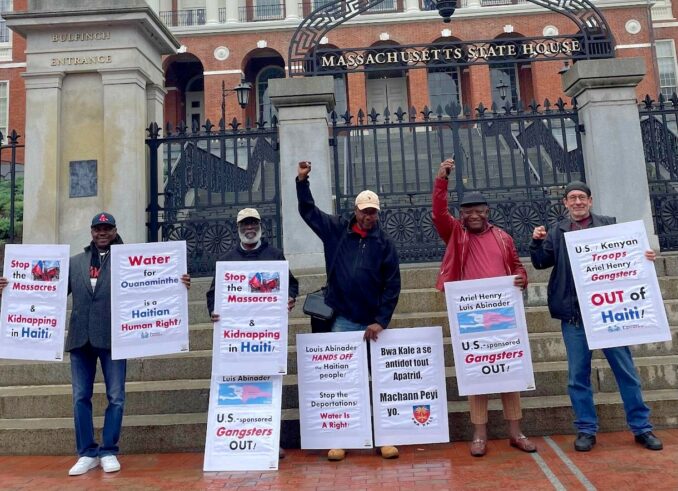Fanmi Lavalas of Boston protests U.S. role in Haiti
Boston
Fanmi Lavalas of Boston responded to the deepening humanitarian and political crises in Haiti with a protest at the Massachusetts State House on Sept. 29. The action drew attention to multiple U.S. interventions and attacks on Haitian sovereignty as the root cause of these crises, which are causing increasing mass casualties, suffering and forced migration from the Western hemisphere’s most impoverished country.

President André François (second from right) of the Boston school bus drivers’ union joins Fanmi Lavalas–Boston at the Massachusetts statehouse protest, Sept. 29, 2023. Credit: WW Boston bureau
The emergency protest came four days after “U.S. Defense Secretary Lloyd Austin signed a five-year deal with Kenya’s Defense Minister Aden Duale in which Washington will give money, weapons, and training to the East African country to work as its proxy in Africa and Latin America. … The deal comes as Kenya prepares to lead a foreign military intervention into Haiti, even before the U.N. Security Council has voted on whether to approve such a force.” (Haïti Liberté, Sept. 27)
Leaders of Steelworkers Local 8751, the Boston School Bus Drivers’ Union, including President André François and Recording Secretary Claude “Toutou” St. Germain joined Jacques Piquant and other leaders of Fanmi Lavalas of Boston in the demonstration. Fanmi Lavalas is the party of the only popularly elected president in Haiti’s history, Jean-Bertrand Aristide.
The U.S.- coordinated violent military coups that overthrew President Aristide in 1991 and again in 2004 — on the 200th anniversary of Haiti’s revolutionary liberation from French colonialism — have created the situation today where no current Haitian government officials, from members of Parliament to prime minister, have been elected by the people.
Ariel Henry was appointed prime minister in July 2021 by the ad hoc Core Group, which consists of the U.S., the United Nations, France, Brazil, Canada, Germany, Spain, the European Union and the Organization of American States. His appointment followed the assassination by Colombian and U.S. mercenaries of the previous U.S.-anointed president, Jovenel Moïse.
Protesters braved a cold rain to hold high signs that read, “U.S./Kenyan Troops, Ariel Henry/Gangsters: Out of Haiti!” and “Stop the Massacres and Kidnappings,” which have become daily crimes against the masses in Haiti. Another Fanmi Lavalas sign read “The Unelected Haitian Gov’t is the Chief Gangster! Self-Determination for the Haitian People!”
Every day, Haitian police, at Henry’s command and armed and trained by the U.S. military, gas, beat and gun down unarmed workers attending large protests against poverty conditions and the de facto government. Any internal social chaos gripping Haitian neighborhoods was created by U.S. intervention.
‘Water for Ouanaminthe is a Haitian human right!’
Protesters spoke with great urgency about the humanitarian crisis unfolding in Ouanaminthe, a commune of 100,000 people in the region of Haiti’s Nord-Est Department, where the Massacre River forms a section of Haiti’s border with the Dominican Republic.
Luis Abinader, president of the Dominican Republic, has ordered the border totally closed to all Haitian nationals, suspended visa applications and initiated daily mass deportations of Haitian people who live, work and seek medical care there. Normally, the border is open without restriction at least two days per week.
Abinader’s lockdown tactic comes as the Biden administration has placed new restrictions on Haitian people wanting to travel or migrate to the U.S. Thousands of people line up daily under the guns of the U.S. Marines at the often-closed U.S. embassy in Port-au-Prince, at barbed wire military checkpoints in El Paso, Texas, and now on both sides of the Massacre River. Many Haitians are drowning in the Gulf of Mexico due to these policies.
Abinader’s mass punishment targets the people of Ouanaminthe, who have been forced by hunger and thirst during an unprecedented drought to begin digging a canal to irrigate their subsistence croplands from the Massacre River. The Dominican Republic has declared the river its exclusive water, despite the countries’ shared island river border.
U.S. uses Dominican Republic against Haitians
There are people alive today who remember the slaughter of an estimated 40,000 Haitian people by the army of the U.S.-backed Dominican regime of Rafael Trujillo in 1937, on the pretext that people were stealing grazing cattle. Piquant of Fanmi Lavalas spoke of “the U.S. using the Dominican Republic against Haiti to attack the gains of the Haitian Revolution.”
There have been dozens of U.S. interventions and military occupations since 1804 against the world’s first successful rebellion of enslaved African peoples. In 1844, U.S. President John Tyler — who owned and abused enslaved people on his prominent settler family’s Virginia plantation and gained the White House by campaigning for genocidal Manifest Destiny against Indigenous nations — connived with Spain and France to sponsor the establishment of the Dominican Republic. Its government has been manipulated since — like in 1916-1924 and 1965 through brutal U.S. military occupation — as a bulwark against the spreading Haitian and Latin American liberation movements. (“Confronting Black Jacobins: The United States, the Haitian Revolution and the Origins of the Dominican Republic,” Gerald Horne, 2015)
Two signs wielded by protesters today expressed the determination of the Haitian people to continue waging resistance against imperialist attacks and exploitation: “Pèp Ayisyen an Pap Fè Bak Sou Konstriksyon Kanal Irigasyon Rivyè Masak La” (The Haitian people will not back down on the construction of the Massacre River irrigation canal.) and “Sèl Pèp La Ki Pou Sove Pèp La.” (Only the People Can Save the People.)
Steve Gillis is a 37-year member and an elected leader of the Boston School Bus Drivers Union, United Steelworkers Local 8751, now working for the members and retired from driving.

